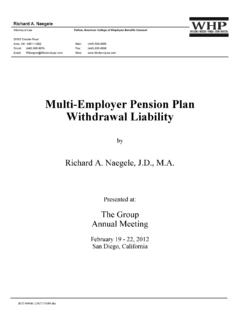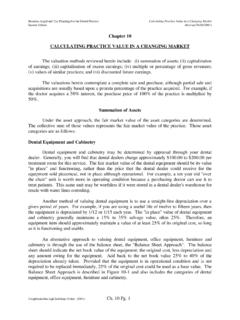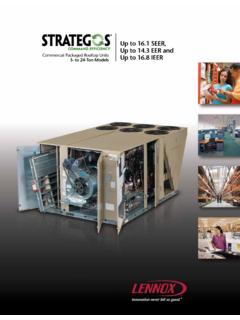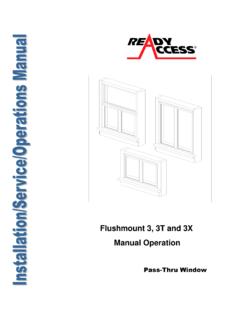Transcription of Employee Stock Ownership Plans (ESOP) - Wickens Law
1 Richard A. Naegele Attorney at Law Fellow, American College of Employee Benefits Counsel 35765 Chester Road Avon, OH 44011-1262 Main: (440) 930-8000. Direct: (440) 930-8074 Fax: (440) 930-8098. Email: Web: Employee Stock Ownership Plans (ESOP). by Richard A. Naegele, Wickens , Herzer, Panza, Cook & Batista Co. (Avon, Ohio). Cleveland Tax Institute November 3, 2010. \ Employee Stock Ownership Plans (ESOP). by Richard A. Naegele, I. INTRODUCTION. A. ESOP Is a Stock Bonus plan Where the Employer Uses Stock as a Financing Vehicle. 1. An ESOP can either be a Stock bonus plan or a Stock bonus and a money purchase plan . It must be qualified under 401(a), and be designed to invest primarily in Qualifying Employer Securities (QES). See 4975(e)(7); ERISA 407(d)(6). 2. Although the term ESOP has been used to describe a variety of qualified Plans which hold employer securities, one of the primary features of an ESOP is that the employer's Stock is used to secure a loan.
2 The loan is usually from a commercial lender, and the loan proceeds are paid to the party selling Stock to the ESOP. This party could either be the company or an individual shareholder. The loan is then repaid through deductible employer contributions to the ESOP which, in turn, repays the loan. Profits or accumulated earnings are not a pre-requisite for the employer contributions to the ESOP. to be deductible. B. Pension Protection Act of 2006 Requirement of Diversification of Investments in Employer Stock . 1. The Pension Protection Act of 2006 requires any defined contribution plan holding publicly traded employer securities to permit participants to diversify account balances invested in such employer securities. At least three materially different investment alternatives must be available. 2. The diversification requirements apply to Employee elective deferrals and after-tax contributions.
3 3. Participants with three or more years of service must be permitted to diversify the investment of employer contributions ( , employer matching or non-elective contributions). This rule is phased in ratably over three years for securities acquired prior to 2007 (except for participants age 55 or older with 3 years of service by the first plan year beginning in 2006; such participants may diversify 100% in 2007). Applicable plan Year Percentage 2007 33%. 2008 66%. 2009 100%. 4. Participants must receive 30 day advance notice of the diversification requirement. A. $100 per day penalty per participant applies for failure to provide the notice. The DOL. will provide a model notice. 5. These provisions do not apply to ESOPs that have no elective deferrals, after-tax contributions, or matching contributions and do not form part of another qualified plan . Collectively bargained Plans and affected ESOPs have later effective dates.
4 2010 by Richard A. Naegele Employee Stock Ownership Plans (ESOP) 1. \ C. In Addition to Benefiting Employees, ESOPs Can Be Used to Benefit Employers and Shareholders. 1. Facilitating a company's cash flow and raising capital. If the company provides the Stock , it can provide an immediate benefit to employees with an amortized cost. A company can also use an ESOP to raise capital without selling its Stock in the general market. A leveraged ESOP can be used to obtain loans to effectively deduct both principal and interest on the loan repayment. 2. Providing a market for non-marketable Stock and estate planning techniques. Often shareholders of private or closely held corporations have difficulty finding a market for their Stock . An ESOP can create a friendly buyer while at the same time providing an incentive for employees who now have an Ownership interest. Estate planning is facilitated because currently a shareholder who sells Stock to an ESOP can defer taxes on the gain by purchasing Qualified Replacement Property (QRP).
5 See 1042. 3. Employee incentive. One of the principal benefits of an ESOP can be Employee motivation. In order to be successful, however, the program must be properly communicated to employees in a positive fashion and followed-up with efforts to continue Employee involvement. 4. Other uses of ESOPs. Exchanging Stock in a family-owned business for Stock which is more readably tradable;. fighting take-overs (note: fiduciary duty requirements could preclude this option if the financial transaction is less favorable to the ESOP than it is to other parties); and as part of a plan to help a company go private. D. ESOP as Shareholder Exit Strategy. 1. An ESOP can provide an exit strategy for a shareholder who may have concerns about selling his or her business in more conventional methods. For example, some shareholders only want to sell a portion of their Stock , are concerned about the tax consequences of selling their businesses (including the ability to generate sufficient funds to pay estate taxes if their businesses are not sold prior to death) or are concerned about the impact that selling their businesses may have on their employees.
6 These issues can often be addressed with an ESOP. 2. In addition to the Code and ERISA ESOP rules, ESOPs can also involve other areas of the law. For example, because an ESOP will become a shareholder of the Employer, state corporate laws often need to be considered along with the Code and ERISA ESOP. rules. Sometimes an ESOP transaction may raise issues under federal and state securities laws. Just like any other transaction involving the purchase or sale of a business, an ESOP transaction required knowledge of many different areas of the law. 3. The selling shareholders may elect to sell any amount of their Stock from a small block to 100%. Selling a small amount of Stock initially will help to make the transaction more easily financed. If 1042 treatment is to be elected, however, the ESOP must own at least 30% of the outstanding shares following the transaction. If a stepped sale approach is adopted, the selling shareholders may remain in control of the company until a controlling block of shares is transferred to the ESOP.
7 Such an approach can help the company to avoid excessive leverage. 2010 by Richard A. Naegele Employee Stock Ownership Plans (ESOP) 2. \ 4. Personal tax planning. An ESOP can be a key component of a major shareholder's personal tax plan . Although an ESOP cannot be contractually bound to purchase employer securities in advance of the purchase date (Treas. Reg (a)(7)(i); DOL Reg. (a)(6)), a shareholder's personal tax plan could take into account an ESOP which could provide liquidity before or after the shareholder's death. II. REQUIREMENTS OF AN ESOP. An ESOP Must Be Established to Invest Primarily in Qualifying Employer Securities (QES). A. Definition Is More Restrictive Than Under ERISA. QES are common Stock issued by the employer, which are readily tradable on an established securities market. Alternatively, with respect to non-tradable securities, QES constitute an employer's common Stock which have a combination of voting and dividend rights which equal or exceed the common Stock of the employer which has the greatest of those rights.
8 See 4975(e)(8) and 409(i). B. Primarily Invested in Employer's Securities Means More Than Fifty Percent. This is a Department of Labor requirement. An ESOP, however, will not lose its qualification status because investments in QES temporarily go below fifty percent. C. Special Controlled Group Rules Apply in Testing QES Definition. These rules are set forth at 409(l)(4), and are based upon the controlled group rules of 1563(a). However, with respect to a parent-subsidiary, a fifty percent test, as opposed to an eighty percent test, is used. D. ESOP cannot consist of preferred Stock unless the preferred Stock is at all times convertible into common Stock which constitutes QES. 409(l)(3). E. Leveraged ESOP Assets Must Be Held in a Suspense Account. As the ESOP loan is repaid, assets from the suspense account are proportionally allocated to the participant's account pursuant to one of two described formulas.
9 Treas. Reg 54-4975-7(b)(8)- 11(c). F. Participants Generally Must Have the Right to Receive Their Distributions in the Form of Stock . An ESOP, however, is not precluded from making distributions in cash. 409(h). Also, an employer can have a right of first refusal to buy back the Stock from a participant if the Stock is not publicly traded and was purchased with an exempt loan. Reg. (b)(9). G. Participants of ESOPs of banks or companies whose Stock Ownership is substantially restricted by law or by charter. Participants of ESOPs of banks or companies whose Stock Ownership is substantially restricted by law or by charter do not have to be given the right to receive distribution in Stock . 409(h)(2) and (3). Additionally, if the sponsoring corporation's charter or bylaws restrict Stock Ownership to the ESOP or current employees, Stock will not be distributed to former participants.
10 H. Participants in S Corporation ESOPs Do Not Have the Right to Receive Distributions in Stock . 2010 by Richard A. Naegele Employee Stock Ownership Plans (ESOP) 3. \ I. Prohibited Transaction Exemption. ESOPs qualify for exemption from many of the prohibited transaction provisions of 4975. including the entitlement to enter into an ESOP loan transaction. J. Certain Voting Rights Must Be Passed Through the ESOP to the Participants. If the QES are subject to 12 of the Securities Exchange Act of 1934 and, thus, are publicly traded, a participant must be allowed to direct the plan on how to vote his allocated shares. If the QES are not publicly traded, the participants need only be given the right to direct their votes on corporate matters with respect to the approval or disapproval of any corporate merger or consolidation, recapitalization, reclassification, liquidation, dissolution or sale of substantially all assets of a trade or business.






